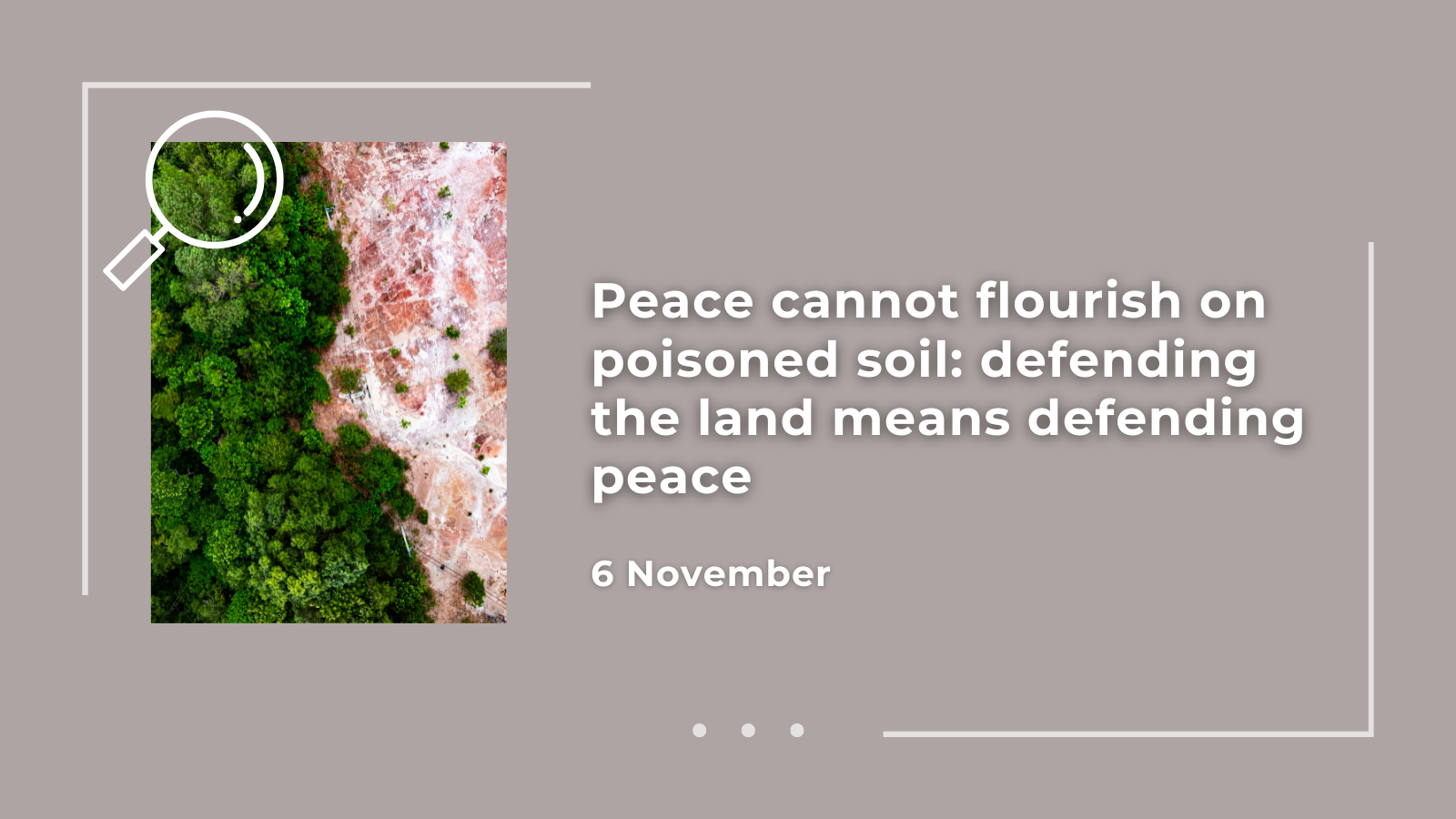
Peace cannot flourish on poisoned soil: defending the land means defending peace.
Every November 6, the world commemorates the International Day for Preventing the Exploitation of the Environment in War and Armed Conflict, proclaimed by the United Nations General Assembly in 2001 through Resolution A/RES/56/4. This date seeks to remind us that ecosystems, natural resources, and biodiversity are also victims of human conflicts, and that their protection is essential to ensuring peace, security, and the survival of future generations.
The environment has historically been the forgotten “collateral damage” of war. Soil and water pollution, massive deforestation, habitat destruction, and the exploitation of natural resources as spoils of war leave deep wounds that persist long after the ceasefire. For this reason, the United Nations recognizes that protecting the natural environment in times of conflict is inseparable from protecting human life, environmental justice, and the reconstruction of sustainable societies.
From a legal standpoint, there are international instruments that set clear limits on environmental devastation caused by conflict. In its Articles 35 and 55, the Additional Protocol I to the Geneva Conventions (1977) expressly prohibits the use of methods or means of warfare that may cause widespread, long-term, and severe damage to the natural environment, reminding us that its destruction endangers the health and survival of civilian populations. Similarly, the Rome Statute of the International Criminal Court (1998) includes among war crimes (Article 8.2.b.iv) attacks that cause disproportionate damage to the natural environment in relation to the military advantage gained.
In 2016, the United Nations Environment Assembly highlighted the direct link between healthy ecosystems and conflict prevention, and in 2022, the International Law Commission adopted the Principles on the Protection of the Environment in Relation to Armed Conflicts (PERAC), a set of 27 principles covering prevention, mitigation, and post-war reparative measures. These advances reflect a growing consensus: peace cannot be built on poisoned soils or polluted rivers.
In recent years, the debate on recognizing ecocide as an autonomous international crime has gained momentum. The proposal to add Article 8 ter to the Rome Statute seeks to criminalize unlawful acts committed with knowledge that they will cause severe, widespread, or long-lasting environmental damage. This step would mark a historic milestone in the fight against environmental impunity and the advancement of global ecological justice.
The United Nations Environment Programme (UNEP) plays a key role in assessing and responding to environmental crises arising from conflicts. Since 1999, it has conducted post-crisis environmental assessments in regions such as the Balkans, Afghanistan, Sudan, Ukraine, and the Palestinian Territories, providing diagnoses and recommendations to restore ecosystems and reduce risks to health and livelihoods.
Contemporary conflicts demonstrate that the environment remains a silent victim of war. In Ukraine, the destruction of industrial and agricultural zones, soil and river contamination, and the collapse of infrastructure have caused irreversible damage. The most dramatic example was the destruction of the Kakhovka dam in June 2023, which flooded hundreds of square kilometers and released toxic pollutants into rivers and the Black Sea. This ecological disaster, considered the most severe of the war to date, illustrates how environmental devastation becomes a weapon of war threatening the health, food security, and future of millions of people.
In Gaza, UNEP warned of the collapse of the water and sanitation system, contamination of the coastal aquifer, and the near-total loss of vegetation. With over 78% of infrastructure damaged or destroyed and millions of tons of debris contaminated by industrial waste and heavy metals, the environmental crisis exacerbates an unprecedented humanitarian emergency. The destruction of the natural environment compromises not only the population’s immediate survival but also the possibility of sustainable reconstruction.
Other conflicts, such as those in Sudan, Yemen, or Syria, show that environmental degradation can be both a cause and a consequence of war. In Sudan, desertification and poor resource management fuel local clashes; in Yemen, overexploitation of aquifers and water scarcity worsen displacement and poverty; while in Syria, armed group activities have caused deforestation, oil pollution, and biodiversity loss, transforming vast agricultural regions into arid, uninhabitable areas.
November 6 reminds us that protecting the environment in times of war is a matter of ethics, justice, and collective survival. Ecological damage knows no borders: polluted air travels, waters mix, ecosystems collapse in chain reactions. Therefore, the international community must demand accountability for environmental crimes, strengthen monitoring and reparations mechanisms, and promote ecological transition policies even in post-conflict contexts.
The destruction of the natural environment has profound consequences for health, water access, food security, and social stability. Protecting nature in times of conflict is protecting life itself.
Sara Zanon, contributor to FIBGAR



